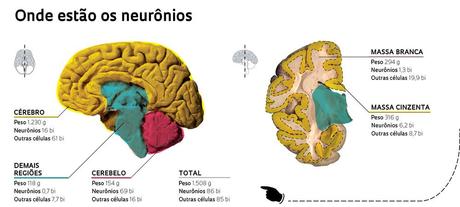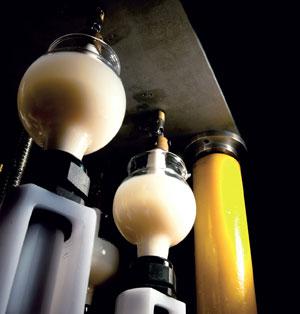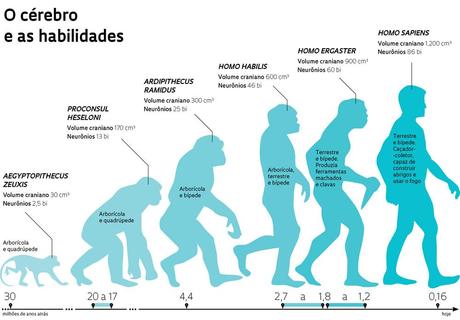This article is my translation of this Brazilian article by RICARDO ZORZETTO (with lots of help from google translate)
Revising the Numbers

Get to know the anatomy of the human brain, especially how researchers got to a figure of 86 billion neurons,instead of the 100 billions previously estimated.
—- On Wednesday, January 11, researchers Casarsa Frederico Azevedo and Moraes Carlos Humberto performed an unusual task for neuroscientists. They covered a shelf along the wall with white cardboard to hide the window behind it. They cleared a granite benchtop, moving beakers, pipettes and reagents to an adjacent bench already littered with glassware and equipment. They were preparing Dr. Roberto Lent’s lab at the University Federal of Rio de Janeiro (UFRJ) for a photo and video shoot. They wanted to record in detail the operation of a machine they began creating seven years ago, which they plan to patent–the automated cell fractionator. Good scenery couldn’t hurt.The complicatedly-named device is almost a meter high and resembles a garbage disposal. It contains electric motors that rotate at 400 RPM, and six plastic pistons attached to a mobile base. Each piston is contained in a glass container, which is filled by samples of brain tissue bathed in a detergent solution. Once on, the fractionator’s pistons stir the colorless solution creating vortexes that break the samples. After two hours the pieces of brain tissue pieces dissolve into a milky mixture, that the researchers have affectionately dubbed “suco de cérebro” or brain juice.
The machine being tested at the Laboratory of Neuroplasticity Institute of Biomedical Sciences (ICB) at UFRJ is a turbocharged version of a much simpler fractionator–a manually operated glass tube and a glass piston– that Lent had worked on previously with neuroscientist Suzana Herculano-Houzel and used since 2004 to break up pieces of brain into cells. Their new technique allowed them to measure more precisely something we thought we already knew: how many neurons there are in the cortex and in other regions of the brain.
Today we know, thanks in part to the work of the Rio de Janeiro group, that the human brain has 86 billion neurons, not the 100 billion claimed years ago. They also show with more certainty, that these neurons are accompanied by 85 billion glial cells (a non-neuronal cell type), a figure well below the trillion announced before.Those aren’t just details. Accurately quantifying the number of brain cells and where they are, is important for trying to understand how the brain works and the strategies nature adopted to build an organ so complex that, in humans anyways, it allows a self-conscious mind.Quantifying brain cells, could also help identify characteristics that distinguish a neurotypical brain from a neurodiverse one.But counting brain cells is not sufficient to understand one of the most intriguing and exciting organs, because modern neuroscience considers the brain to be more than just a collection of neurons.
According to Italian neuroanatomist Alessandro Vercelli, what is equally or more important than number of cells, is the way neurons connect to form distributed information processing networks. ”The number, the standard and quality of these connections vary with space and time,” says Martin Cammarota, a neuroscientist who studies memory formation and recall. ”Having more neurons neurons does not necessarily make a given person more intelligent than another or one species more intelligent than another.”

Despite the importance of other factors, the data that Suzana and Lent collected since 2005 led them to question some canonical ideas about the composition and structure of the brain. Last year, Lent felt that the data was consistent enough to be consolidated into a more direct critique of earlier ideas. He and three lab members wrote a review published in January in the European Journal of Neuroscience in which said at least four dogmas of neuroscience need to be reexamined.
The first dogma discussed in the article is that the brain has 100 billion neurons. Known to many, this figure has circulated in scientific articles and textbooks for nearly 30 years. In 2001, Lent himself published a book titled ‘Cem bilhões de neurônios’ [One hundred billion neurons] which is used in graduate courses.Origin
This book, incidentally, is to a certain extent somehow the source of the doubts that motivated the UFRJ researchers to investigate how many cells within the brain. Shortly before its release, Suzana had initiated a study to assess the knowledge of high school students about neuroscience and university. One of the 95 statements that they had to say it was right or wrong was: use only 10% of the brain. Almost 60% of 2200 respondents said yes, was correct.
This statement–wrong because we use the whole brain almost all the time–derives from a 1979 presentation by Canadian neurobiologist David Hubel, who won the Nobel Prize in Physiology or Medicine in 1981. [I've heard other origins of this myth.] Hubel claimed the brain had 100 billion neurons and 1 trillion glia. This claim was repeated by other publications, and because neurons are the processing units of information–and would represent only a tenth of brain cells–it was concluded that the other 90% of the brain were not used.
The result bothered Suzana, so she searched for the original source of these numbers int the scientific literature but didn’t find it. She raised her doubt with Lent: “How do you know that there are 100 billion neurons?” Lent said, “Look, everybody knows, every book says so.” Many articles and books repeated the information, but without a source. ”The number became so cemented that people quoted it without much thought,” said Lent.
One of the reasons why these numbers are difficult to find, is that counting brain cells is no easy matter. Besides being a large organ–the human cortex is about 1,200 grams and the whole brain, 1,500–its architecture is complex. Distinct areas contain varying concentrations of cells and the technique was available for counting them, stereology, only works well for small regions with homogeneous cell distribution. Its application to brain cells generated unreliable estimates, with range an order of magnitude in some regions, and put the human brain somewhere between 75 billion and 125 billion neurons.
Having recently been hired by UFRJ, Susan told Lent she had a “bold but kind of crazy” idea of how to count neurons but no laboratory. He invited her to work with him. Suzana’s proposal was simple: make the brain regions homogenous before counting their cells. How? By breaking apart the cells. The main reason for the variation in number of cells in different brain areas, is that the cells within them and spaces between them vary in size. By dissolving the cells, the issue would be resolved, provided nuclei are perserved. Because every brain cell has a single nucleus, the sum of the nuclei would give the total cells. Dye marking neurons allowed them to be distinguished from glia.

© LEO RAMOS - The turbo-charged fractionator transforms pieces of the brain into a soup of nuclei
Using chemical compounds that preserve cell structures, Suzana managed to destroy just the external membrane without damaging the nucleus, and with Lent, described the technique in a 2005 issue of The Journal of Neuroscience. “It’s an ingenious, simple and easy method to use and replicate,” comments Vercelli. “I wonder why no one ever thought of this before.” In the opinion of Zoltan Molnar, a neuroscientist from the University of Oxford, in England, it was an important advance. “Genomics, transcriptomics and proteomics are quantitative and accurate areas that have made a lot of progress, while we anatomists have remained in the dark ages. We haven’t developed methods that can measure the number, density and variations in cell architecture,” he says.
The first test was on the brains of rats. The total number of cells in the encephalon was 300 million, of which 200 million were neurons. Unexpectedly, only 15% of them were in the cortex, the most voluminous part. Most (70%) were found in a smaller region at the bottom and back of the skull, the cerebellum.
This was true in rats, but what about other species? Suzana then analyzed the brains of another five rodents (mice, hamsters, guinea pigs, pacas and capybaras). As was already known, the bigger the animals had bigger brains and more neurons. The mouse, weighing just 40 grams, is the smallest and has 71 million neurons, stored in a brain weighing 0.4 grams. Almost 1,200 times heavier, the capybara has an encephalon 183 times bigger (76 grams), but only 22 times more neurons (1.6 million).
The human brain
Supervised by Suzana and Lent, biologist Frederico Azevedo counted the cells in human brains. First, however, he had to adapt the technique. “What functioned with rodents didn’t work for humans,” he says. It took months before he discovered that the problem lay in the way the tissue was fixed before fractioning it. When the brain was immersed too long in compounds that avoid its deterioration the researcher was unable to color the neurons in order to be able to count them by microscope. Frederico fractioned by hand the brain samples of four people (ranging in age from 50 to 71), which were supplied by the brain bank of the University of São Paulo (USP). “This was when I began thinking of a way to make this work automatic,” says the biologist, who is doing a PhD at the Max Planck Institute in Germany.
The cell count revealed that the human brain has on average 86 billion neurons, or 14% less than the previous estimate and close to the number suggested in 1988 by Karl Herrup, from Rutgers University. “There are those who say that the difference is small, but I disagree,” says Suzana. “It corresponds to the brain in a baboon or half the brain of a gorilla, one of the primates that in evolution terms is closest to human beings,” explains the neuroscientist, who is head of the Compared Neuroanatomy Laboratory of ICB-UFRJ.
Lent comments cautiously: “We can’t state that these numbers are representative of the human species. It’s probable that they’re representative of mature adults.” Or not even this, since only four brains were analyzed. In younger people, it might also be different. “Who knows whether individuals in the 20-year old age group might not have 100 billion neurons that they lose over time?” asks the researcher. His group is now studying the brain of younger people and comparing brains of men and women. Until he answers this question, Lent has altered the title of the second edition of his book, published in 2010, to Cem bilhões de neurônios? [One hundred billion neurons?], with a question mark at the end.
The cerebellum
Just as in rodents, most of these neurons are not in the brain but in the cerebellum. The brain (more specifically the cerebral cortex, until quite recently considered primarily responsible for cognitive functions such as attention, memory and language) is the part of the encephalon that has grown largest throughout evolution. In the human case, it weighs 1,200 grams and occupies more than half the skull, but houses just 16 billion neurons. The cerebellum, on the other hand, weighing 150 grams, has 69 billion cells (see infographics above).
How can we explain the different sizes of these organs? The answer is manyfold. First, the brain has fewer neurons than the cerebellum, but almost four times as many non-neuronal cells, such as glia. These cells, once seen merely as the physical support for neurons, perform other essential functions: they help transmit impulses, feed the neurons, defend the central nervous system from invading microorganisms, and–of course–occupy space. Second, the brain and the cerebellum are formed from different types of neurons, which are connected in different ways.

© Source: ROBERTO LENT / UFRJ
In doing this work, the group from Rio also found that evolution did not favor just the development of the brain. Among mammals, the class of animals to which human beings belong, the brain and the cerebellum gained neurons at the same pace. This result, according to Vercelli, corroborates that of research, indicating that the role of the cerebellum does not merely control movement. It is fundamental for learning, memory, the acquisition of language and control of behavior and emotions. “It’s being increasingly shown that the cerebellum participates in processes that we previously only associated with the cerebral cortex,” comments Herrup from Rutgers.
The strategies
Since developing the technique, Suzana has already applied it to study the brains of 38 species of mammals and found that over the last 90 million years nature has adopted at least two strategies to build brains; one for rodents and another for primates.
In rodents, the number of neurons in the brain increases logarithmically. Generally speaking, as the size of the species increases, the brain becomes bigger and the absolute number of neurons does as well. However, the bigger rodent species get, the fewer neurons they gain proportionately. On the other hand, among primates, which include monkeys and human beings, the increase is linear: the number of neurons increases proportionally to cerebral volume. “There was an abrupt transition between lower mammals, like rodents, and the higher mammals, like primates,” comments Vercelli. According to Lent, this change allowed the brain of primates to pack more neurons in a smaller volume and acquire more cells than rodent brains.
This pattern of brain development in primates led Suzana and Lent to question another idea that had been accepted for nearly 40 years: that the human brain is exceptionally large compared to other primates. In 1973, American paleoneurologist, Harry Jerison, said that our brain was seven times bigger than what one might expect of a 70-kilogram mammal. Neuroscientist Lori Marino later said that it was large even for a primate. At almost 1,500 grams, the human brain is the biggest among all the primates – the gorilla, the biggest primate, weighs 200 kilos and has a 500-gram brain. However, the assumption that brain size is a good indicator of neurons, now seems false.
Setting aside brain mass and analyzing the number of cells, it is seen that the human brain does not differ from the pattern for primates. “Our brain have the number of cells to be expected for a primate of this size,” says Suzana.
Based on this rule and the volume of the skull, in 2011 Suzana and neuroscientist Jon Kaas, from Vanderbilt University in the United States, published in Brain, Behavior and Evolution an estimate of the number of brain cells of another nine hominids. As was to be expected, the species that is closest to humans (Homo sapiens) in terms of neuron numbers is Neanderthal man (Homo neanderthalensis), who lived between 30,000 and 300,000 years ago in the region where Europe is today. They had 85 billion neurons, according to Suzana and Kaas’ estimate. With the help of bioanthropologist Walter Neves, from USP, Lent expanded the projection to include other species of primates that belong to the super-family of hominids and calculated that the Neanderthals may have had 100 billion neurons (see infographic above).
Another dogma being questioned is that the total number of glial cells exceeds the number of neurons ten-fold. This is the source of the idea that only 10% of the brain is used. “This high rate of glial cells is taught in text-books, although experiments were already indicating that the proportion was 1 to 1,” says Helen Barbas, from the University of Boston.
Besides the much lower number of glial cells (there are 85 billion in human beings, and they are concentrated more in the brain than in the cerebellum) what most surprised Suzana is that glia underwent practically no morphological changes during evolution. Their size is almost constant among the primates, while the size of neurons has varied by a factor of 250. “The functioning of glial cells must be tuned so tightly that nature eliminates any change from arising,” she comments.
It’s expected that more exciting results will appear as the Brazilian technique spreads. “If it’s widely used it can simplify the tedious process of counting brain cells,” says Herrup. Perhaps even more hours can be saved if the turbo-charged version of the fractionator is as efficient as expected.
—————-
You may be interested in my post: Connectome: How the Brain’s Wiring Makes Us Who We Are – Sebastian Seung’s new book
References
1. LENT, R. et al. How many neurons do you have? Some dogmas of quantitative neuroscience under revision. European Journal of Neuroscience. v 35 (1). Jan. 2012.
2. HERCULANO-HOUZEL, S.; LENT, R. Isotropic fractionator: a simple, rapid method for the quantification of total cell and neurons in the brain. Journal of Neuroscience. v. 25(10), p. 2.518-21. 9 Mar. 2005.
3. Herculano-Houzel S, Kaas JH. Gorilla and orangutan brains conform to the primate cellular scaling rules: implications for human evolution. Brain Behav Evol. 2011;77(1):33-44. Epub 2011 Jan 11.







